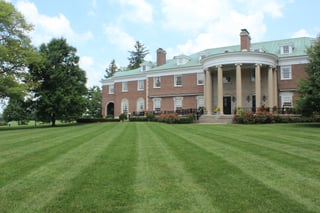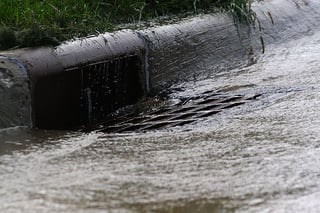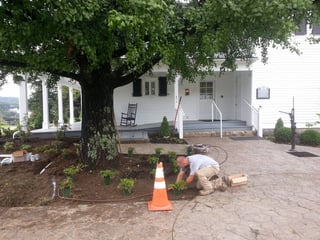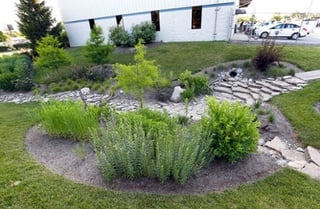When we talk about decreasing our environmental footprint or creating sustainable landscapes, the concept feels so big—and the little things we do for our landscapes might not seem like enough to make a difference. But this is not the case at all! In fact, all the small steps we include in the landscape maintenance routine can add up to a significant, positive impact on the environment.
Indeed, the little things do make a big difference.
So, as a property manager, what eco-friendly techniques can you implement into your landscape maintenance routine to benefit your property and the surrounding environment? Here are some suggestions based on the best practices we use at Klausing Group. We encourage you to think differently about your landscape—give your grounds purpose. Your landscape can do more, and here are nine eco-friendly landscaping tips to start doing today.
Leave Grass Clippings On The Lawn

Before you bag those grass clippings and leaves, let’s address the benefits green debris can deliver to the soil and turf roots. Did you know lawn clippings and leaf debris can provide 1 pound of nitrogen per year to your lawn? That’s 1 pound of nitrogen saved from your fertilization program—and the nitrogen nature produces is the best kind. This also adds much needed organic matter to the soil, another important factor in creating lush lawns. At Klausing Group, we implement a Naturally Better Turf Program — a mix of natural and synthetic products with a focus on optimizing soil health. We use Monty’s humic technology (a Kentucky product) and focus on building soil health—because we know, healthy soil makes for healthy plants.
Harvest Rainwater To Irrigate New Plants And Annuals
Plants don’t require potable water. So, put a rainwater harvesting system (like a rain barrel) in place and use this recycled water to irrigate plants. You’d be surprised how much water you can capture—and how you can decrease your municipal water use for irrigating the landscape. Tap into a natural resources falling from the sky to keep your plants healthy, and save money on your water bill, too.
Keep Lawn Debris From Entering Storm Sewers
 When grass clippings, leaves and other debris from your lawn enter storm sewers, this organic material becomes a real burden to storm water sewer systems and can negatively impact waterways. Organic matter and excessive nutrients are choking our rivers, streams and lakes. Excessive nutrients disturb the ecosystem and prevent wildlife from thriving in these areas. All we have to do in order to make a positive impact is to train our grounds maintenance staffs to keep clippings and leaves on lawns and out of stormwater sewers and waterways.
When grass clippings, leaves and other debris from your lawn enter storm sewers, this organic material becomes a real burden to storm water sewer systems and can negatively impact waterways. Organic matter and excessive nutrients are choking our rivers, streams and lakes. Excessive nutrients disturb the ecosystem and prevent wildlife from thriving in these areas. All we have to do in order to make a positive impact is to train our grounds maintenance staffs to keep clippings and leaves on lawns and out of stormwater sewers and waterways.
Consider Biological Controls
Do you really need to spray a pesticide to get rid of landscape disease, or insects harming plants or turf? In fact, there are beneficial insects doing the work of pesticides—they’re nature’s pest control, referred to as biological controls. A proactive pest management approach can do more for your landscape because it addresses true pest problems and avoids possible harm from traditional treatments. Integrated Pest management (IPM) involves proper plant selection and choosing varieties that attract beneficial insects. For example, beneficial insects can parasitize white grubs. Beneficial insects can also be purchased from breeding companies and released into the landscape (very effective against spider mites). The goal is to create a balanced ecosystem where pests cannot develop into pest problems.
Recycle and Compost Yard Waste
Some landscape contractors dispose of compostable material, sending valuable organic debris to the landfill. Instead, we suggest alternative waste management practices. For example, Klausing Group’s leaf debris goes to a local non-profit for use in community food gardens. This is literally one way we turn green “trash” into treasure—nutrient-rich compost that builds up the soil and creates a productive garden for growing vegetables.
Modernize Your Irrigation System
 Technology evolves over time—so the irrigation heads, controllers and accessories (rain sensors, weather stations) installed years ago are not going to be as efficient and effective as newer, modern components. Ask your landscape maintenance provider to conduct an irrigation system analysis to evaluate whether there are opportunities for upgrades. It may be time for an irrigation system upgrade if you have added more landscaping or turf areas, you notice dead spots, or you installed new plants requiring more water than the previous material. Is your water bill too high? This could be the indicator of an inefficient irrigation system. There might be leaks, breaks or malfunctioning components increasing water usage and driving up the cost of irrigating your property.
Technology evolves over time—so the irrigation heads, controllers and accessories (rain sensors, weather stations) installed years ago are not going to be as efficient and effective as newer, modern components. Ask your landscape maintenance provider to conduct an irrigation system analysis to evaluate whether there are opportunities for upgrades. It may be time for an irrigation system upgrade if you have added more landscaping or turf areas, you notice dead spots, or you installed new plants requiring more water than the previous material. Is your water bill too high? This could be the indicator of an inefficient irrigation system. There might be leaks, breaks or malfunctioning components increasing water usage and driving up the cost of irrigating your property.
Select Native Plants
Native plants are designed by nature to thrive in Central Kentucky. Native plants are adapted to the soils and climate in this region, so they perform better than other species. They do well with basic landscape maintenance—and deliver rich ecosystem benefits. Therefore, you get a return on investment for including native plants in your landscape. The value deepens when you integrate native plants into a landscape design with bioswales or raingardens. Rain gardens help absorb water and help it percolate into the soil; and they filter contaminants, preventing harmful substances from entering our stormwater systems and waterways. (Check out Klausing Group’s raingarden for ideas.)
Promote Green Infrastructure

Green infrastructure involves incorporating ecological services into your landscape. What are those exactly? We’re talking about landscape features that reduce stormwater runoff, harvest rainwater, reduce energy consumption, improve water and air quality, and contribute to an overall healthier environment. (Perhaps even improving employee performance.) While the term green infrastructure can be intimidating—we encourage you to stop and consider which projects you can take on gradually so your landscape can do more than just look good. Green infrastructure is a natural solution for the drainage, heat, air and water quality problems we face on our commercial properties. It includes: raingardens, green roofs, permeable paver surfaces, urban tree canopies, and thoughtful plant selection. Here is a guide to what green infrastructure means and how you can implement it one step at a time.
Bonus Eco-Friendly Landscape Best Practices
Find out if your community certifies businesses for sustainable business practices. For example, Klausing Group became Green Check Certified through a program offered by Live Green Lexington. Remember, sustainability goes beyond a company’s service offerings and includes the landscape. Your property is a reflection of who you are as an organization and what you stand for. Also, look into electric or hybrid vehicle options. And, choose landscape and garden equipment that is cleaner for the environment. There are a range of electric products on the market now for residential use, and the commercial eco-friendly equipment market is expanding.
Ask The Expert: How Can Your Landscape Do More?
There are many small steps you can take to make a big, positive impact on the environment—and it all starts with how you maintain your Central Kentucky commercial property. Looking for ideas? Want to see and experience how green infrastructure works? (We invite you to visit our headquarters!) Let’s start a conversation. Call us any time in Lexington at 859-254-0762 and Louisville at 502-263-0127. Or, fill out this simple form and request a proposal.


